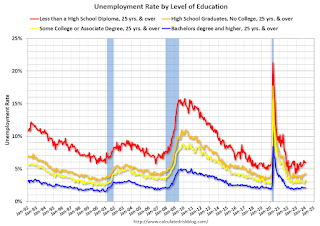Unfortunately, this data only goes back to 1992 and includes only three recessions (the stock / tech bust in 2001, and the housing bust/financial crisis, and the 2020 pandemic). Clearly education matters with regards to the unemployment rate, with the lowest rate for college graduates at 2.1% in January, and highest for those without a high school degree at 6.0% in January.
All four groups were generally trending down prior to the pandemic. And all are close to pre-pandemic levels now (less than high school is a little higher than pre-pandemic).

Note: This says nothing about the quality of jobs – as an example, a college graduate working at minimum wage would be considered “employed”.
This brings up an interesting question: What is the composition of the labor force by educational attainment, and how has that been changing over time?
Here is some data on the U.S. labor force by educational attainment since 1992.
Currently, over 64 million people in the U.S. labor force have a bachelor’s degree or higher. This is over 44% of the labor force, up from 26.2% in 1992.
This is the only category trending up. “Some college”, “high school” and “less than high school” have been trending down.
Based on current trends, probably half the labor force will have at least a bachelor’s degree sometime next decade (2030s).
Some thoughts: Since workers with bachelor’s degrees typically have a lower unemployment rate, rising educational attainment is probably a factor in pushing down the overall unemployment rate over time.
Also, I’d guess more education would mean less labor turnover, and that education is a factor in lower weekly claims.
A more educated labor force is a positive for the future.
